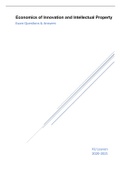Tentamen (uitwerkingen)
Economics of Innovation and Intellectual Property: Example Exam Questions & Answers 20-21
- Instelling
- Katholieke Universiteit Leuven (KU Leuven)
Example exam questions with my answers on the theory of Economics of Innovation and Intellectual Property, taught by Prof. Pellens in at KU Leuven.
[Meer zien]












